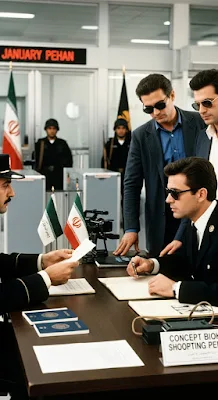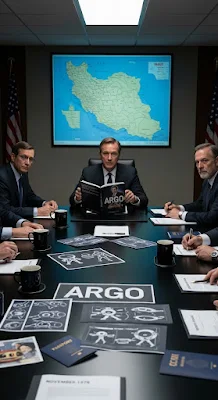🪶 Introduction
“We pretended to be filmmakers… but we were rescuers.”
In late 1979, Iran was in the midst of a revolution.
The Shah had fled, Ayatollah Khomeini had returned, and anti-American sentiment was reaching a fever pitch.
Then, on November 4th, the unthinkable happened: Iranian militants stormed the U.S. Embassy in Tehran,
taking 52 Americans hostage in what would become a 444-day ordeal.
But amid the chaos, six American diplomats managed to slip away, finding refuge in the homes of Canadian officials.
Their escape marked only the beginning of an impossible mission—
to exfiltrate them from a country in full revolt, with every airport, border, and hotel under surveillance.
The solution? A fake Hollywood science fiction movie.
🧠 Background: A Country on the Edge
Following the fall of the Shah, Iran’s internal security network had fractured, but its paranoia had not.
The revolutionary regime viewed spies and Western interference as existential threats.
Foreigners were closely watched. Travel documents were inspected with suspicion.
Iran’s airport security operated like an intelligence checkpoint, not a place of travel.
Against this backdrop, any traditional method of extraction was destined to fail.
The CIA needed a cover that was so unexpected, so culturally disarming,
that it would lower the guards—both literally and psychologically.
That’s when CIA exfiltration expert Tony Mendez proposed one of the most creative operations in U.S. intelligence history:
“Let’s pretend we’re making a science fiction movie.”
“Every prop, every passport, every line… was part of the script.”
🎬 Operation Argo: A Movie That Never Was
The CIA teamed up with Hollywood makeup artist John Chambers,
best known for his work on Planet of the Apes,
to set up a completely fabricated production company: Studio Six Productions.
They chose a generic sci-fi script called Argo, about a galactic rebellion on a desert planet—
the perfect excuse to scout “Middle Eastern-looking locations.”
Every detail was manufactured:
-
Film posters
-
Concept art
-
Business cards
-
Production office with a real L.A. phone number
-
Ads placed in Variety magazine
Mendez and Chambers even held a fake press party in Hollywood,
inviting actors and producers to create the illusion of a real, buzz-worthy movie.
The brilliance of the plan lay in one insight:
Authoritarian regimes may distrust diplomats, but they respect show business.
The disguise wasn’t just believable. It was seductive.
“This wasn’t deception. It was creative warfare.”
🛫 The Airport Scene: A Real-Life Thriller
The six escapees were outfitted with Canadian passports and trained to pose as a Canadian film crew.
Each was given a new name, job title, and backstory—
from director to cinematographer to location scout.
Mendez flew to Tehran alone, briefed them, and rehearsed their roles like a Hollywood director.
On January 28, 1980, they walked into Tehran’s Mehrabad Airport,
smiling, holding storyboards, and carrying production gear.
Tension rose as guards scrutinized their documents.
One wrong word, one moment of hesitation—
and the entire team could be imprisoned, tortured, or worse.
After hours of questioning, the airport officials finally allowed them to board the plane.
“All six accounted for. We are airborne.”
“These weren’t props. They were shields.”
🎥 Why the Plan Worked
The Argo mission is now studied in both intelligence and film schools
because it succeeded not through superior firepower or surveillance,
but through narrative design.
Here’s why it worked:
-
Cultural camouflage: Few things confuse a checkpoint more than something that seems unrelated to espionage.
-
Overload by detail: The more elaborate the story, the harder it becomes to disprove.
-
Psychological disruption: The operation exploited the regime’s blind spots, including its lack of familiarity with Western movie culture.
In espionage, sometimes believability matters more than truth.
“The cast never acted. They survived.”
🏆 From Fiction to Oscar Gold
After the mission’s success, Canada received public credit,
while the CIA’s role remained classified for nearly two decades.
When the truth finally emerged, it seemed too outlandish to be real.
Hollywood took notice.
In 2012, Ben Affleck directed and starred in “Argo,” dramatizing the rescue mission.
The film was a critical and commercial success,
winning Best Picture at the 85th Academy Awards.
A fake movie—once a tool for deception—became a global story of bravery and ingenuity.
📚 What We Learned
The Argo mission taught the world something profound:
Narratives aren’t just for stories. They are strategic tools.
In a world obsessed with facts, sometimes it takes a good lie to reveal the deepest truths.
✅ Conclusion
A mission that began with makeup and storyboards ended with freedom and applause.
The six Americans didn’t just walk out of Iran—
they walked straight into history.
📺 Watch the full story on YouTube
👉 https://www.youtube.com/@DisnamEdu
🌏 Read in Korean




Comments
Post a Comment